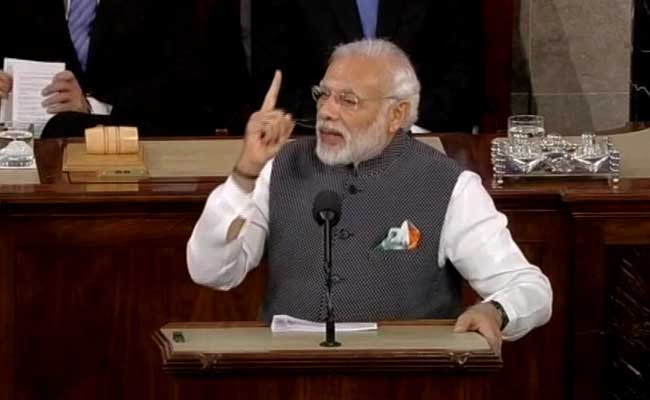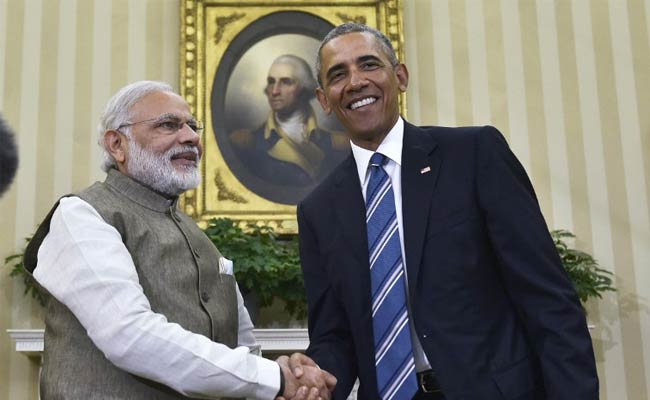The speech to the joint meeting of the Houses was letter perfect. It ticked off every box - from Lincoln to Gandhi, Martin Luther King to Ambedkar, Vivekananda to Walt Whitman; the salute to "the shared ideals and common philosophy of freedom"; the common threat perception from terrorism; the quest for a meaningful partnership that was fundamental to India's development, and could re-order the world to America's comfort.
In Washington, DC, where the US Congress has emerged as Pakistan's toughest interrogator on terrorism, Modi presented his case subtly but effectively. His talking up the Indian diaspora on previous visits - which some analysts dismissed as little more than an ego trip - paid dividends too. After all, this is an election year and Congressmen seeking re-election need every vote and every fundraising opportunity they can get. Being on the right side of India and welcoming of its popular Prime Minister could do no harm domestically.

PM Modi addresses a joint sitting of the US Congress in Washington on Wednesday
The bond and working relationship between President Barack Obama and Prime Minister Modi has surprised many. In fact, sections of the American press, including The New York Times and Washington Post - which competed with each other for thin and non-substantial coverage of the visit and its implications - have spent the past two years continuing to be surprised by it and rehashing the same stories and same sets of quotes.
True, Modi and Obama are very different individuals with very different backgrounds. Yet, Modi is more of a thinking man than his critics give him credit for, and Obama more of a consummate, goal-oriented politician than his gushing fans believe. They met as strangers two years ago - but there has been no sign of estrangement since then. That is why those who claim to be still surprised by the friendship do themselves and their sense of analysis no credit.
As the Modi-Obama talks and joint statement made apparent, behind the bonhomie, there was give-and-take and transactionalism. The Paris climate change talks and their successful conclusion are an important element of the Obama legacy. India, under Modi, emerged as a constructive problem-solver in Paris. By committing India to "full implementation" of the Paris Agreement and making substantive reference in the joint statement to a clean energy initiative that will involve India-US commercial and technological partnerships in nuclear and solar energy, Modi gave Obama enough to be able to sell back home.

PM Narendra Modi shakes hands with US President Barack Obama during a meeting in the Oval Office of the White House
In turn, Obama welcomed India into the Missile Technology Control Regime and promised to support its entry into the Nuclear Suppliers' Group (NSG). These are crucial clubs for access to sensitive, dual-use technology. The expectation now is that Obama will use his political capital to persuade China to agree to open the NSG door. The coordinated US-India diplomacy of 2008 - in the run up to the NSG waiver to India - could return. The G20 meeting in September in Hangzhou, where Obama and Modi will meet again, is a possible milestone.
It is facile to suggest that very little of the above is specific and that these are works in progress. We need to measure Modi's Mission America not in terms of just one visit but as an aggregation of the achievements of a set of interactions in the US and in India, including when President Obama arrived in January 2015. From climate change to defence ties, from nuclear commerce to the testy intellectual property argument, the "not give an inch" rhetoric of the past is giving way to a "let's make it work" maturity.
Rather than a perennial complainer, Modi's India has emerged as a doer. A case in point is Pakistan and terrorism. Without taking recourse to the old wailing sheet and cribbing to everyone about Islamabad, Modi has devised a mechanism to shape the debate to India's advantage. The joint statement says the US and India "will work together to combat the threat of terrorists accessing and using chemical, biological, nuclear and radiological materials". It also has the US promising to participate in a "Summit on Countering Weapons of Mass Destruction Terrorism" to be hosted by India in 2018. The message to Rawalpindi is obvious.
Postscript: On another note, the tantalising prospect of an India visit by Obama before his term ends in January 2017 is alluded to in the joint statement. One wonders if a quick, post-G20 stop is on the cards?
(The author is distinguished fellow, Observer Research Foundation. He can be reached at malikashok@gmail.com)
Disclaimer: The opinions expressed within this article are the personal opinions of the author. The facts and opinions appearing in the article do not reflect the views of NDTV and NDTV does not assume any responsibility or liability for the same.


